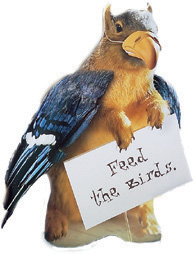-
Foiled by the Squirrel Baffle
He’s arch enemy number one to most backyard birders! Raiding bird feeders relentlessly until empty, they continue even to destroy the feeder itself. Squirrels can be an impossible pain in the keester, no matter how you try to solve the problem.
To the rescue…a quality squirrel baffle placed in the correct position. When installed properly, squirrel baffles make it impossible for these furry critters to get
at feeders. Because of their amazing acrobatics, you must always remember it’s not just the height from the ground, but the horizontal distance from any jumping spot. They can leap tall buildings at a single bound, so feeders must be at least eight feet away from where squirrels can get a foot hold and jump across.
With the investment of a squirrel baffle (and they really aren’t even that expensive) you’ll save money by saving birdseed. You’ll also allow your feathered friends to dine in peace, thus seeing more of the activity you were hoping for.
If the squirrel baffle is a pole mounted one, be sure the bottom of the baffle is at least five feet from the ground. Squirrels will shimmy on up the pole, but will be foiled every time by the baffle. Knowing that you’ve finally won the battle, it’s a pretty entertaining site too!
-
Bird Cams Site Worth Checking Out
Bird food, houses and birdbaths, we set them up in hopes of attracting feathered friends to our yards. We start watching and begin to notice much more about birds. Hoping to catch a glimpse of a new species every now and then, we simply “bird watch” and are taken away to another realm.
With the introduction of bird cams, we can catch so much more about bird’s nesting behavior and raising their young. It’s almost like a secret window into another world. The quality is superb, and allthough the price of bird cams has come down substantially, it’s still a pretty hefty investment for some.
Thanks to the Cornell Lab of Ornithology, there’s a terrific site for viewing multitudes of bird cams in one place. The Nest Cams Project site offers viewers a drop-down menu of specific birds and their nesting process. They do ask for a donation to keep this site up and running, but for most choices on the menu you can scroll down to see some great video highlights. Definitely worth checking out!
From the Cornell Site: “Your gift keeps NestCams rolling on the fascinating behavior of breeding birds. Millions of web visitors have witnessed live video of birds courting, mating, laying eggs, and raising young. Thank you for supporting this project!”
-
Want more birds at your nyjer feeder?
There are no set rules in wild bird feeding, we offer birds different varieties of food that entice them and keep them coming back. Of course habitat plays a huge role, with places for shelter and nesting like mature trees, thickets and shrubs. The all important water source is also a big factor for attracting feathered friends.
Just because finches eat thistle, or nyjer seed, doesn’t mean they wont’ frequent other feeders offering different seed mixes. For the last few days, I’ve been seeing Black Capped Chickadees at the nyjer feeder. Now maybe it’s just the time of year, but I’ve never seen them at this feeder before. Also, the juvenile Eastern Bluebirds, who will eat suet during our cold winter months, have already started feeding at the suet feeder too.
A favorite treat for several birds is to mix thistle seed with finely chopped sunflower hearts. Placing this seed mix in the nyjer feeder attracts Juncos, Pine Siskins, Towhees and House and Purple Finches, as well as the Goldfinch.
In early spring, try offering nesting materials and encourage birds to take up residence by nesting in your yard. Collect dryer lint, pet hair, cotton yarns and fibers, and decorative mosses to create a nest ball with variety of materials that birds prefer. You can place them in a standard suet cage, or mesh produce bag from the grocery store. Of course commercial materials are available, and even some cool holders to accommodate them.
Just because the bright yellow feathers disappear in fall, it doesn’t mean these birds are gone. Remember to keep nyjer feeders out year round with fresh seed, as goldfinches and others will stick around during during winter months.





